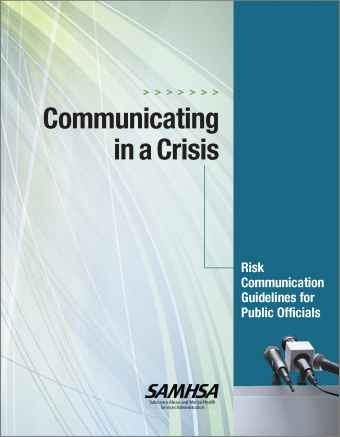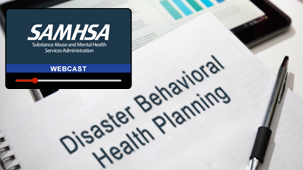
Disaster Behavioral Health Communication, Planning, and Preparedness |
Disaster behavioral health planners need access to appropriate resources to assist them in preparing their communities for disasters. Preparing communities for disasters includes creating all-hazards disaster behavioral health plans, as well as implementing strategies for communicating information before, during, and after crisis events. The following resources provide disaster behavioral health professionals with information for communicating through all phases of a disaster, as well as planning and preparing for disaster events. |
Communicating in a Crisis: Risk Communication Guidelines The SAMHSA DTAC has updated this guide for public officials and other professionals who may be involved in disaster and emergency communications. It provides information on communicating complex information, working with the media, and using social media effectively. The SAMHSA DTAC has updated this guide for public officials and other professionals who may be involved in disaster and emergency communications. It provides information on communicating complex information, working with the media, and using social media effectively. |
Introduction to Promising Practices in Disaster Behavioral Health Planning This webcast is the first in the nine-part Promising Practices webcast series. The webcast gives an overview of promising practices in disaster behavioral health planning and shares successful examples that have been implemented in the field. This webcast is the first in the nine-part Promising Practices webcast series. The webcast gives an overview of promising practices in disaster behavioral health planning and shares successful examples that have been implemented in the field. |
Stronger Together: Community-level Disaster Behavioral Health In this edition of the Supplemental Research Bulletin, SAMHSA DTAC explores examples of community-level approaches to preparing individuals and families for disasters. It also describes approaches to disaster response and recovery related to mental health and substance use issues, such as the Federal Emergency Management Agency Crisis Counseling Assistance and Training Program and PsySTART. In this edition of the Supplemental Research Bulletin, SAMHSA DTAC explores examples of community-level approaches to preparing individuals and families for disasters. It also describes approaches to disaster response and recovery related to mental health and substance use issues, such as the Federal Emergency Management Agency Crisis Counseling Assistance and Training Program and PsySTART. |
Effectively Communicating With the Whole Community in Disasters At this web page, the U.S. Department of Homeland Security lists communication tips to help states, territories, and tribal governments ensure they are reaching the entire community during a disaster. The tips promote non-discrimination by providing information in all major languages and building capabilities to communicate with individuals with limited English proficiency. At this web page, the U.S. Department of Homeland Security lists communication tips to help states, territories, and tribal governments ensure they are reaching the entire community during a disaster. The tips promote non-discrimination by providing information in all major languages and building capabilities to communicate with individuals with limited English proficiency. |
Help Improve SAMHSA’s Disaster Services and Products As a subscriber to this newsletter, you are invited to participate in a short, web-based survey to provide the SAMHSA Disaster Technical Assistance Center (DTAC) with feedback about your experiences with our products and services. The survey should take no more than 15 minutes. Complete the survey by clicking on this link, or copy and paste the URL https://iqsolutions.qualtrics. As a subscriber to this newsletter, you are invited to participate in a short, web-based survey to provide the SAMHSA Disaster Technical Assistance Center (DTAC) with feedback about your experiences with our products and services. The survey should take no more than 15 minutes. Complete the survey by clicking on this link, or copy and paste the URL https://iqsolutions.qualtrics. |
Subscribe to The DialogueThe Dialogue is a quarterly e-newsletter that provides practical and down-to-earth information for disaster behavioral health coordinators, local service providers, federal agencies, and nongovernmental organizations. You can subscribe to the newsletter or contact the SAMHSA Disaster Technical Assistance Center (DTAC) by email at dtac@samhsa.hhs.gov to contribute an article to an upcoming issue. |
Questions About the SAMHSA DTAC Bulletin?The SAMHSA DTAC Bulletinis a monthly newsletter used to share updates in the field, post upcoming activities, and highlight new resources. For more information, please contact: The views, opinions, and content expressed in this publication do not necessarily reflect the views, opinions, or policies of the Center for Mental Health Services (CMHS), the Substance Abuse and Mental Health Services Administration (SAMHSA), or the U.S. Department of Health and Human Services (HHS). |





















.jpg)









No hay comentarios:
Publicar un comentario